Houseplants are a great way to add some color to your home. The greenery in the foliage of common houseplants can make any living space vibrant and even add a sense of calm that makes the room inviting.
However, sometimes you might be interested in more than just the green that such plants provide. In this case, you should choose houseplants with eye-catching shades in their foliage and blooms.
This article presents eight colorful houseplants you should grow indoors to brighten your living space.
Table of Contents
1. Croton

The Croton is a tropical plant with exceptional color variations on its leaves.
This unusual plant’s thick, leathery foliage can have different colors on the same plant, such as red, yellow, orange, and green.
Some rare varieties also have pink and purple pigmentation on the leaves, making the Croton one of the most colorful plants you can get for your home.
The leaves are also available in different shapes, so take time to find a plant with a leaf shape that strikes your fancy.
When grown outdoors in tropical conditions, Crotons can grow up to 10 feet tall but will not grow that tall when confined to a pot. Even so, the plant still needs a bit of space to thrive indoors.
The best place to grow Crotons is close to a south-facing window that receives a lot of direct sunlight.
Crotons need a lot of sunlight for the leaves to be bright, and their signature colors could fade to a dull green without enough sun exposure.
Grow your rCotons in well-draining potting soils. The soil should be moist but not soggy to keep the roots properly aerated.
- Sun requirement: Bright, direct light.
- Water needs: Weekly.
- Plant height: 4 to 10 feet.
2. Nerve Plant
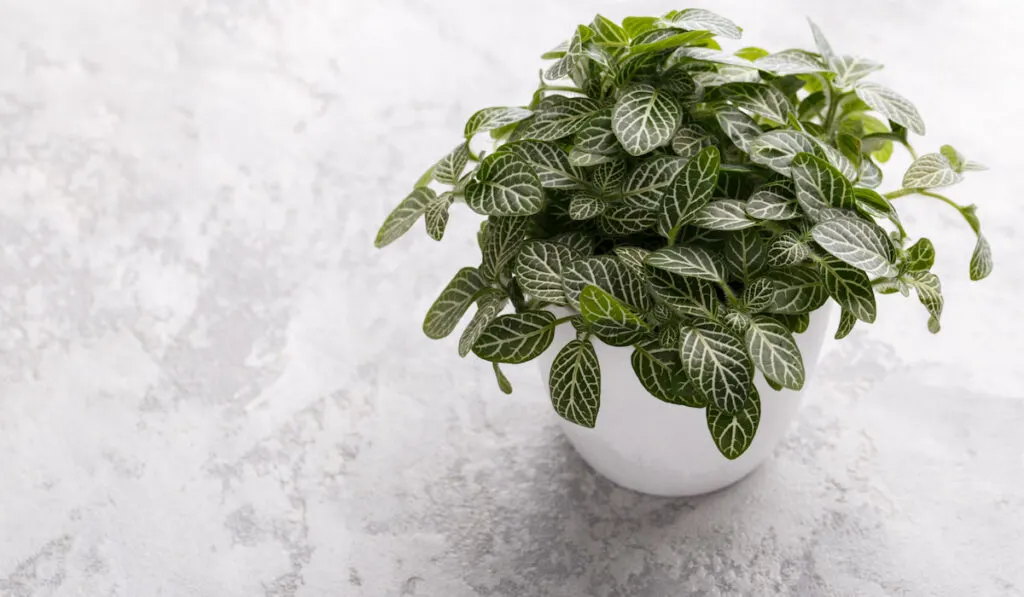
The nerve plant is another plant that will add a dash of color to your living space. The plant got its name from its colored veins that resemble the nervous system.
The leaves of the nerve plant are mesmerizing with white, red, or pink veins on its oval-shaped light or dark green leaves.
Nerve plants do well in humid conditions, making great terrarium plants since they remain compact after planting.
Alternatively, you can grow them in a humid location in your house, such as a shelf in your bathroom, so they can benefit from the warmth and humidity.
While these low-growing plants don’t need a lot of direct sunlight to thrive, the color in the foliage pops when exposed to light.
Therefore, it helps to place your nerve plant close to a bright window to take in natural light.
- Sun requirements: Medium indirect light.
- Water needs: Bi-weekly.
- Plant height: 3 to 6 inches.
3. African Violet
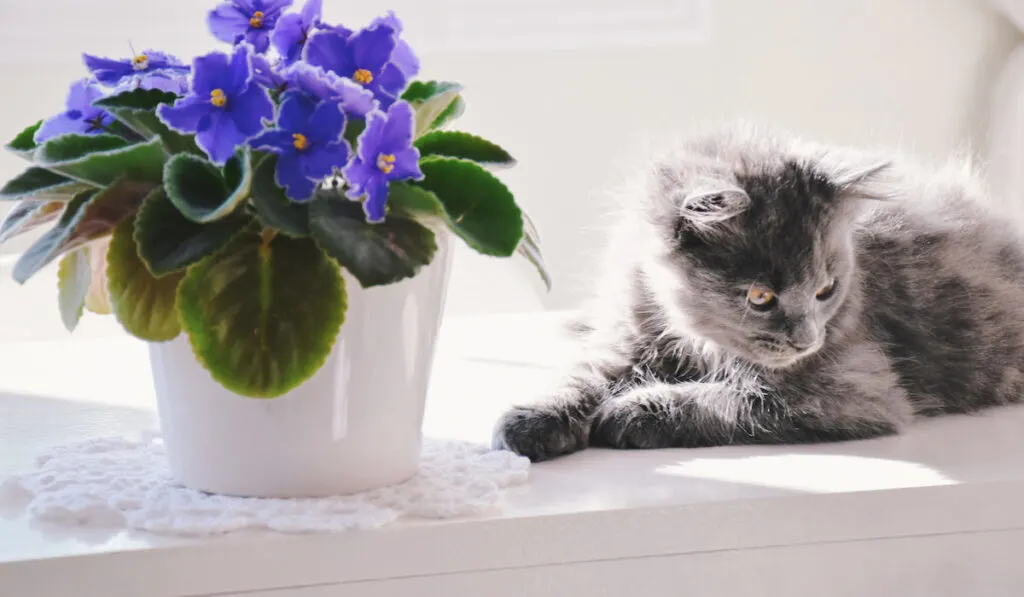
Do you want a colorful houseplant that can survive in a corner of your living room with minimal watering? Consider getting an African violet.
African violets usually have beautiful flowers and dark green foliage that will add vibrant blue, red, purple, and pink tones to your home.
Some varieties of the African violet have flowers that are ruffled, double-blossomed, or fringed, while others even have fuzzy variegated leaves.
These low-growing plants flower for the better part of the year, making them perfect for adding pops of color to your home during the dull winter months.
They also don’t take up a lot of space, making them an excellent pick if you have a small living room.
The plants can survive with occasional watering but do well when given the right care.
When watering your African violets, do it from the bottom to avoid getting water droplets on the leaves, which will mar them with tan lines and spots.
These little beauties can bloom in low light conditions but will also love a spot on a windowsill with indirect sunlight.
- Sun requirements: Indirect light.
- Water needs: On a need-to basis as determined by the soil.
- Plant height: 3 to 6 inches.
4. Chinese Evergreen

The Chinese evergreen is another great choice for a colorful plant for your living space. This upright, leafy plant is adored by home gardeners because of its attractive and easy-to-manage nature.
With its marbled pinks, reds, yellows, and silver on the leaves, the Chinese evergreen will add beautiful patterns to your house.
The broad leaves of the Chinese evergreen are often spotted or streaked, and a plant may incorporate several of its signature colors.
These beauties produce flowers in a spadix, but people often remove the blooms to increase the plant’s lifespan.
Taking care of these plants is easy, making them great for novice home gardeners who may forget to water their plants regularly.
Moreover, Chinese evergreens do well in low to bright indirect sunlight.
They also don’t need too much water, so allow the soil to dry before watering the plants.
- Sun requirements: Low to bright indirect sunlight.
- Water needs: Once a week.
- Plant height: 1 to 3 feet.
5. Prayer Plant
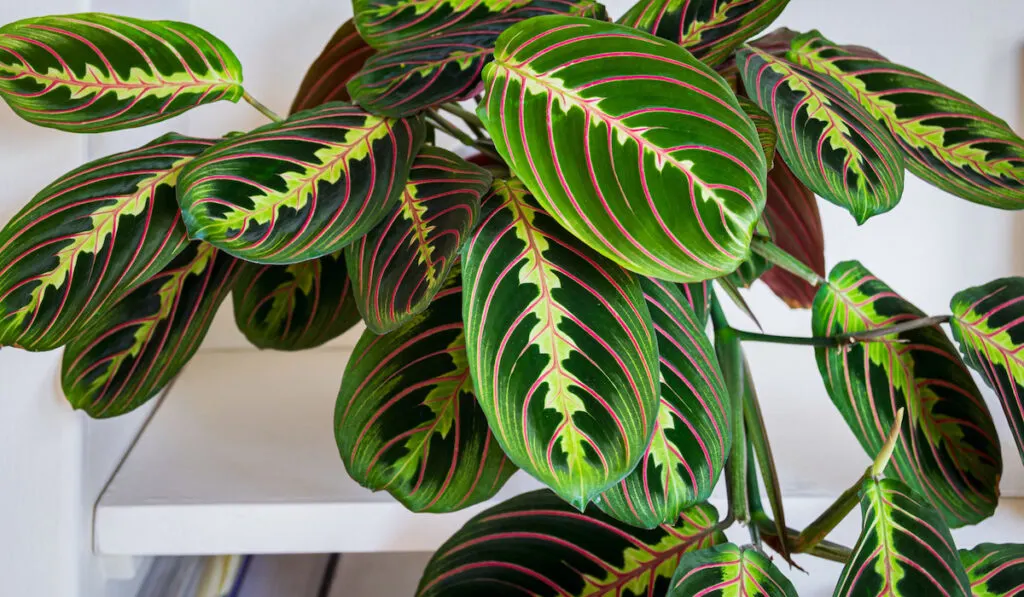
Prayer plants are a staple in many homes because of their large, velvety, vibrant leaves that can add a pop of color to any room.
The leaves of this brightly patterned plant fold to mimic the appearance of praying hands, hence the name prayer plant.
The multicolor foliage of the prayer plant comprises deep green leaves with yellowish splotches along the midrib.
Arching red veins branch out from the midrib and spread out to the margins of the leaves.
Prayer plants love humidity and are best placed close to east- or north-facing bathroom windows.
Should you place your prayer plants in a less humid location in your home, ensure to mist the leaves regularly or place it on top of a humidity tray.
Prayer plants are more cold-hardy than other plants on this list. They have a habit of spreading, hence can also be grown on a hanging basket.
- Sun requirements: Indirect light.
- Water needs: Bi-weekly.
- Plant height: 6 to 12 inches.
6. Anthurium

The Anthurium plant adds a splash of color to any space with its vibrant flowers.
Also known as the flamingo flower, the Anthurium plant gets its name from the flowers it produces — which have bold reddish-pink petals that remind people of flamingos.
Not only are the flowers of the Anthurium plant colorful, but they are also glossy and have a heart shape that’s sure to add romantic tones to your living space.
These easy-to-care houseplants are a great addition to your home with their intricate foliage and heart-shaped flowers that can last 2 to 3 months with proper care.
Flamingo plants can bloom throughout the year, with only a small break during winter. This guarantees that your home will retain its beautiful shine for the better part of the year.
The Anthurium requires medium to bright indirect light to do well. Also, ensure to maintain a consistent watering schedule since the plant doesn’t like to dry out.
Lastly, ensure to fertilize your Anthuriums properly to encourage flowering.
- Sun requirements: Medium to bright, indirect light.
- Water needs: Weekly.
- Plant height: 16 inches.
7. Flaming Katy
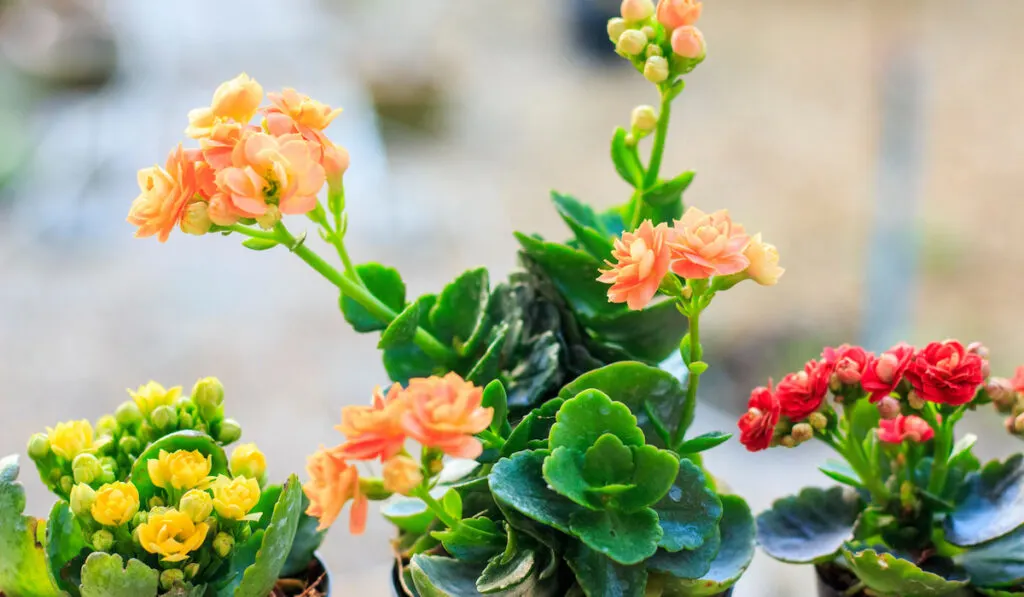
Known for its succulent, patterned leaves, vibrant plantlets growing on the margins of the leaves, and long-lasting flowers, the Flaming Katy is a beautiful houseplant that will add shine and vibrancy to your living space.
The Flaming Katy flowers in bright clusters around the plant. The colors that give this plant its elegant appeal include red, pink, yellow, orange, and white.
As you can see, this is one unique plant and would appeal to anyone looking for an adventurous plant for their home gardening project.
It originated from the arid regions of Madagascar and was bred as a houseplant because of its low maintenance requirements.
The plants require very little water to do well and exposure to bright sunlight to encourage blooming.
- Sun requirements: Full sunlight or bright indirect light.
- Water needs: Weekly in summer and bi-weekly in winter.
- Plant height: 12 to 16 inches.
8. Bird of Paradise
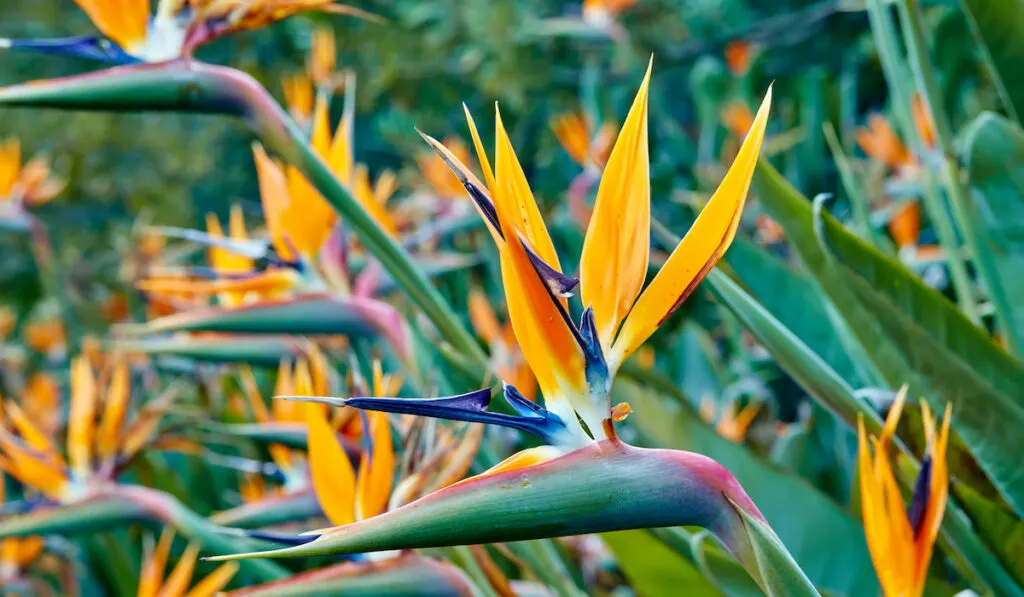
If you want to add a tropical burst of color to your indoor space, the bird of paradise would be the perfect houseplant for you.
When the bird of paradise plant blooms, it gets stunning beak-shaped flowers that look like a bird’s plumage.
The leaves of this plant are large and green, making any space look like a mesmerizing jungle.
Combine these two, and it becomes evident why the plant is called the bird of paradise.
This plant is taller than most of the houseplants mentioned in this post, making it an excellent choice for those with lots of space in their living room.
If you choose to get the bird of paradise, remember that this is a demanding plant that needs a lot of TLC.
This plant needs at least six hours of direct sunlight daily to produce flowers.
They also need warm temperatures and moist soils to do well, so monitor them keenly to ensure the soil doesn’t dry out.
Also, take note that these plants will not bloom till they get to four years of age. But after that, they can bloom several times a year in the right conditions.
- Sun requirements: Full sunlight.
- Water needs: Weekly.
- Plant height: 6 to 30 feet.
Final Thoughts
If you want to add some color to your home, any of the colorful plants highlighted in this post will help you add some excitement to your indoor living space.
Whether you prefer the flamingo plant’s stunning flowers or the Croton’s mesmerizing foliage, each of these houseplants will add its unique charm to your home.
Resources
- https://gardenerspath.com/plants/houseplants/colorful-winter/
- https://www.mydomaine.com/houseplants-with-colorful-leaves-4797391
- https://www.thespruce.com/colorful-houseplants-that-stand-out-5207432
- https://balconygardenweb.com/colorful-indoor-houseplants/
- https://www.allaboutgardening.com/bright-houseplants/
- https://bustlingnest.com/colorful-houseplants/
